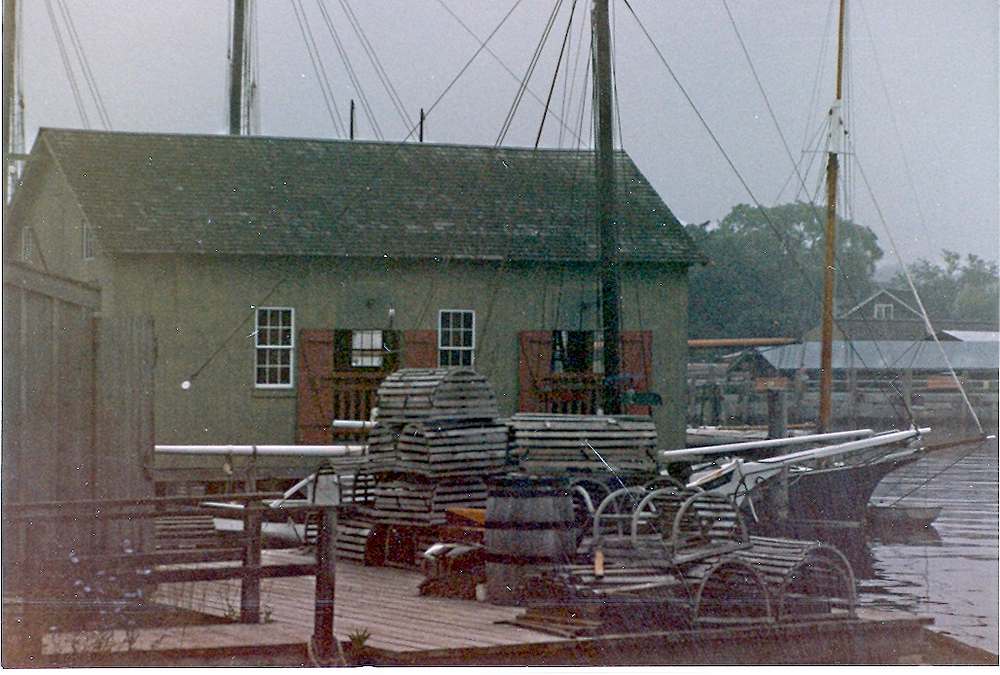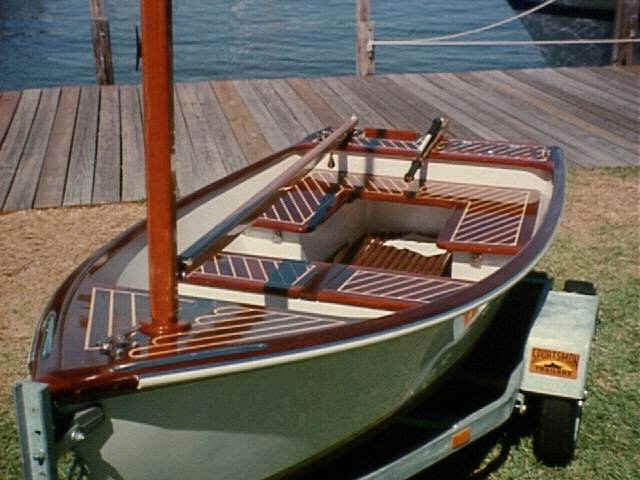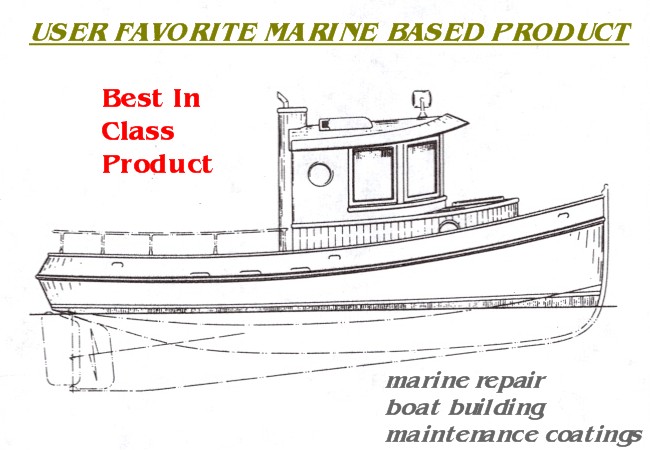|
Doug: " I have your India Spar Varnish on my cedar strip canoe and it looks great! Inside photo of the canoe attached." |
PROGRESSIVE EPOXY POLYMERS, INC.
ABSOLUTE BEST SOURCE for epoxy information, options, USA made products
(EMAIL 603 435 7199)
VARNISH: Find out why traditional Spar Marine Varnish is in trouble. Learn its chemistry
|
Doug: " I have your India Spar Varnish on my cedar strip canoe and it looks great! Inside photo of the canoe attached." |
Traditional varnish (sometimes called Spar Varnish or Marine Varnish) is a resin in an oil base with solvents. It has natural UV protecting properties. It is semi-thick, tends to flow off brushes nicely, imparts a warm amber color to surfaces, and is easy to re-apply over old varnish providing that the old varnish is not too badly degraded. It also sands nicely and, I think, smells good. Another reason to use varnish, even under surfaces you are planning to paint, is that it is easy to remove with a heat gun and get back to the original wood (without paint pigments buried deep into the raw wood finish).
GOOGLE EPOXY / VARNISH SITE SEARCH - Click here
Nothing but Quality Products at Good Prices, Great Customer Service, and Lots and Lots of Helpful Information
and NO SALES TAX - You are shopping in TAX FREE New Hampshire
We are the only technology based coating/epoxy/resin company that actively encourages your business hour phone calls (East Coast), We answer emails 24/7/365. We form a personal relationship with our customers and freely share technical information, how to-advice, product information and tips-and-tricks. Speak with a non-salesman technical professional with over 25 years of experience in the resin/coating industry.
Your Host and Tour Guide:
Paul Oman, MS, MBA - Progressive Epoxy Polymers, Inc. - (floor epoxies, marine epoxies, underwater epoxies, repair epoxies)
Member: NACE (National Assoc. of Corrosion Engineers), SSPC (Soc. of Protective Coatings), BoatUS (since 1980)
Board member: Friends of the Suncook River - 501(c)(3) non profit ----- Founder: Friday Night Paddlers .
WoodenBoat Marketplace sponsor
"Professionals helping Professionals since 1994

Mystic Seaport - Connecticut
|
Add a warming tone to your clear epoxy, solvent based clear coat, or enhance your India Spar Varnish amber tone. Order our 4 ounce "Warm-Tone Dye Solution" additive - good for warming about a gallon of clear coat. Find it in our Marine Catalog/Section 8-Misc. --- Industrial/Home Catalog/Section I-Misc. ---- (It's in the MISC section of our 3rd party storefront when you order online). |
There is an old joke about the man who drank a quart of Varnish. He had a terrible end but a beautiful finish.
That's sort of the story about varnish today. The old fashion varnish is on its way out, which is sad because it
has is such a wonderful product.
Traditional varnish (sometimes called Spar Varnish or Marine Varnish) is a resin in an oil base with solvents. It has natural UV protecting properties. It is semi-thick, tends to flow off brushes nicely, imparts a warm amber color to surfaces, and is easy to re-apply over old varnish providing that the old varnish is not too badly degraded. It also sands nicely and, I think, smells good. Another reason to use varnish, even under surfaces you are planning to paint, is that it is easy to remove with a heat gun and get back to the original wood (without paint pigments buried deep into the raw wood finish).
It is common on wood trim on boats and a common 'trick' is to apply over an epoxy coated surface. That surface
might be the epoxy covered hull of a newly built boat, or an epoxy resin coated piece of wood trim from the cockpit
of a larger boat. The varnish protects the epoxy from UV damage and the epoxy gives the varnish a nice and stable
surface to bond to. The resulting epoxy/varnish coating system is much more longer lasting than either one alone.
Some professionals add extra solvent to the first few coats of spar varnish they are applying over wood. This makes
the varnish thinner and helps it soak into the wood better, thus giving (in theory) better adhesion for the entire
system of multiple coats of varnish (some folks will apply 8-12 coats of varnish rather than a simple 2 or 3).
Note that is may be a violation of local VOC restriction laws.
Another professional 'trick' with spar varnish is to apply it to all uncoated wood surfaces that are to receive a coat
of paint. This way if in the future one wants to give that wood surface a clear coating that shows the wood pattern
(i.e. a varnish or clear poly finish) the varnish first coat will have prevented the paint's pigments from penetrating
into the wood, making sanding away all the pigmented paint much easier.
|
best option for outdoors |
|
|
|
Minwax (tm) oil stain - left to dry for 2 weeks - 2 coats ESP 155 epoxy sealer and primer - 4 coats of India Spar Varnish (note ESP 155 and Varnish not for sale in California) |
read about ESP 155 - one of our top products
always a good idea to have epoxy under your varnish
The problem with traditional
spar varnish / marine varnish is that it contains
lots of solvent, more than air quality, VOC regulations (VOCs are the solvents in products) allow (see www.epoxyproducts.com/voc.html). This is why traditional varnish is often difficult or impossible
to purchase now. Fortunately all states except California have a quart exemption rule. This means you can purchase
quart units of traditional varnish, but not gallon units. California has done away with the quart exemption rule.
Other states are considering it.
Some spar varnish / marine varnish makers may not want to bother with 'only quart cans.' I think some varnish manufacturer (especially outside the USA) may not know the legal rules and I also think that many boat supply stores/hardware shops pretend not to know. Some states allow for the sell of existing old stock.

| Order India
Spar Varnish
Product
NOW from our large Primary web store not in our Secondary online store not for sale in California |
The words 'varnish,' 'marine,' or 'spar' don't seem to mean much of anything and their use is not a guaranty that the product is real, traditional varnish. I have seen products called urethane varnish, spar urethane or simply spar varnish, or simply varnish that is not the traditional varnish product. These new products usually were developed to replace 'real' varnish with a product that as acceptable levels of VOC. With all the ones I have examined they look, smell, apply nothing like real varnish, and in the few tests I have done, did not perform as well (they also tend to be thinner so it takes more coats of them to equal a single coat of real varnish). You have to read the label carefully to see what you are getting. If 'water' and/or 'urethane' appear on the label, it is not traditional varnish.
These new products may, or may become, superior to traditional varnish. I don't like them at this point in time,
but that is personal opinion. You will need to test them yourself to your criteria. In the meanwhile, I will stick
to traditional varnish.
Because real spar varnish / marine varnish is getting hard or impossible to find, we do sell it along with our epoxies. It is our own
private label varnish. -- INDIA SPAR VARNISH -- We take advantage of the quart packing exemption (in all states but California) in order
to sell it. Thus, you can only purchase it in quart cans. This product can be found in our marine catalog at: www.epoxyproducts.com/5_urethane.html
(urethane paints) (it is not a urethane, but all the none epoxy coatings we have go in this section!), and in
our industrial/residential catalog at www.epoxyproducts.com/e_nonepoxy.html
(urethane pants) section.
This product is
featured on the GreatThings4u.com website

Note that this product can only be shipped by ground and cannot be shipped by air or outside the USA. This usually
also precludes shipment to Alaska and Hawaii.
Let's start off by talking about what goes into manufacturing traditional,
‘oil based' (solvent based varnish).
1) resin
2) oil
3) drying agent
4) solvent
5) possible proprietary additives
RESIN: Phenolic resin is considered to be the best, followed by alkyd resin which is more common. However, in checking
out the so called top varnishes, they seem to be a blend of phenol and alkyd. There are also polyurethane resin
varnishes, and there are real similarities between solvent based polyurethanes and traditional varnishes.
OIL: Generally either tung oil or linseed oil. Tung oil is considered better and it probably is but some of the
‘better' is perhaps marketing hype. Usually varnish containing tung oil make it very clear on the label. When used
by itself (not in a varnish product) on wood tung oil is superior to linseed oil. It is not often possible to tell
what oil is used even when viewing the MSDS (material data safety sheet) because unlike the resin and solvent,
it is not considered hazardous and need not be listed. It appears that the best vanishes use tung or a tung oil
/ linseed oil blend. How much better this is than a pure linseed oil is unknown and other factors probably have
more influence than the simple tung oil vs. linseed oil debate. Linseed oil reportedly yellow, darkens, ambers
more than tung oil.
One of those other factors is the ratio of resin to oil. The formulations that use more oil with the resin are
called "long chain varnishes'. Spar varnish differs from ‘regular' varnish by using more oil. The increased
amount of oil in the varnish add more flex to the product, needed outdoors when temperatures and moisture levels
vary so much. Varnish for interior furniture would use less oil and be harder and more brittle varnish than spar
varnish. I suspect that different manufacturers have different resin oil ratios and that the selection of what
resin(s) and which oil(s) also impact the resin oil ratio.
DRYING AGENT: These are small amounts of metallic compounds that get the varnish (and other similar coatings) to
cure. There are probably several options (which drying agent(s) and amount of drying agent) that the manufactures
have to control the dry time of the varnish. You will not find much information on the drying agents used in your
varnish.
SOLVENT: The most common solvent for varnish is mineral spirits (sometimes called stoddard solvent), but I have
seen other solvents used/listed on ‘high end' varnish. Note that the solvent's rate of evaporation varies with
the solvent so the cure time of a varnish is based upon the drying agent and the solvent type and amount.
Most damaging to the sale of varnish is the various groups around the country that regulate air quality by controlling
the amounts of solvents in paints and coatings. Varnish unfortunately takes/requires a lot of solvent. Around 50%
of varnish is solvent, well above the acceptable solvent levels in all US locations. Fortunately all states but
California have what is called the "quart exemption". This allows the sale of high solvent coatings if
sold in quart units.
PROPRIETARY ADDITIVES: We can assume that vanish manufactures add things to their varnish to improve certain properties
that they want to modify. UV absorbers or blockers immediately come to mind. Perhaps (a guess) something to make
linseed oil act more like the more expensive tung oil. Additives that also control cure time and viscosity might
also be used.
VARNISH ALTERNATIVES: The term varnish is generic. Lots of coatings etc. are called varnishes for all sorts of
professional and marketing reasons.
There are water based coating that may be called water based varnish or water based polyurethanes. Most professions
seem to find them not up to the quality and performance of solvent based coatings for exterior use.
There are solvent based 1 part polyurethanes and 2 part polyurethanes (called
LPU coatings) that can be clear or tinted
and used as varnish alternatives. There is also a class of coatings (including clear) that are called polyaspartic
coatings that have increasingly popular. How do these compare to traditional spar varnish?
There is not right or wrong answer. If find the clear LPU coatings to have superior performance but are less user
friendly, more expensive, thinner and lack the warmth and thickness of traditional varnish. I have used them over
varnish with success.
I am still experimenting and testing the new wave of polyaspartic coatings as a varnish alternative. Currently
polyaspartic coatings are used primarily on garage floors.
PERFORMANCE: It is very difficult to rate the performance of different varnish brands against each other. Climate/weather
conditions, surface preparation all come into place besides the varnish itself. I suspect that people that use
the higher priced varnishes, generally spend more time on surface preparation and ‘following the directions', use
a better quality brush, etc. than those the purchase cheaper products.
Our
India Spar varnish (link to our varnish catalog page) is a long chain varnish using a phenolic/alkyd resin. The oil used is unknown
but assumed to be linseed oil. It is not know if any tung oil is included. The solvent is traditional mineral spirits.
| Order India
Spar Varnish
NOW from our large Primary web store |
"I bought some ESP 155 as a prime coat and used your India Marine Spar Varnish on top - unbelievably good! Forty year old mahogany seats in my dingy look as good as the brand new gunwales. Not sure how well it projects on the camera - dark basement- but looks so, so good!" John 1/15
|
Where to Use India Spar Varnish Our India Spar Varnish has three primary applications. 1) applied over a thick or thin layer of epoxy used on table tops and bar tops. Vanish provides necessary UV protection that all epoxies need as well as a wear surface that can be polished to a mirror finish. 2) Varnish is used on 'natural' wood finishes on boats. Again, generally over epoxy (such as in Stitch - and - Glue or wood strip construction) but sometimes directly on the wood. If you using our Basic No Blush marine epoxy (why not?) be sure to wash off and remove any amine blush that might have formed on the surface of the epoxy before you varnish it. Note that spar varnish is a solvent based coating that has been time tested for over a century on boats out in the sun and weather 24/7. You won't find any modern "polyurethanes " on these boats (keep the urethanes for indoor use - better still, use India Spar Varnish on inside applications too). 3) Use India Spar Varnish over naturally finished wood floors, usually over an epoxy primer - ESP 155 (or thicker epoxy like LOW V epoxy - used on shipping container floors) applied over the wood and under the varnish. ONLINE STORE Purchase Here - Cannot be shipped to California. |
|
Marine 1 Page Product/Price list // // Marine Catalog // |
|
--- for DIY/Commercial Catalog |
|
// Help EMAIL US // // Boat Links // // Floor Links // // DIY Repair Links // // BUY online // |
ON-LINE CATALOG HOMEPAGE.
Inside Our non-marine, commercial, DIY Catalog:
corro coat FC 2100; water gard 300; CM 15; crack coat™; liqua tile 1172 potable water
Find Corro Coat FC 2100 and Water Gard 300 epoxy in our Best Selling - fix anything Catalog
water bond (water based); industrial floor epoxy; bio vee seal; walnut shell; rough coat grit filled epoxy floor paint; epoxy clear top resi
wet/dry 700; splash zone A-788, epoxy cream; splash zone a-788
Find Wet Dry 700 epoxy in our Best Selling - fix anything Catalog
low V epoxy; basic no blush; ESP 155; Bio-Clear 810; epoxy clear top resin
Find Low V, Basic No Blush, and ES 155 epoxy in our Best Selling - fix anything Catalog
Aluthane moisture cured urethane; Acrylic Poly UV Plus and other 2 part polys ; Capt. Tolley's creeping crack sealer; india spar varnish;
Find Aluthane in our Best Selling - fix anything Catalog
fumed silica; fiber fill; micro balloons/micro-spheres; graphite; wood flour; EZ thick, rock flour;
water activated pipe wrap; TA 661 solvent-free epoxy brush cleaner; fiberglass tape/cloth
short nap epoxy rollers; epoxy/stone deck resurfacing roller; 1 inch foam brushes; 2 inch bristle brushes; tongue depressors
Questions? / Phone order? / EMAIL / CALL 603-435-7199 EST / BUY ONLINE
GOOGLE SITE SEARCH - Click here Epoxy specific site search
Click here - YouTube video. Learn about Progressive Epoxy Polymers Inc.
EVAL4U - how to evaluate your epoxy vendor - CLICK HERE -
Progressive Epoxy Polymers, Inc.
